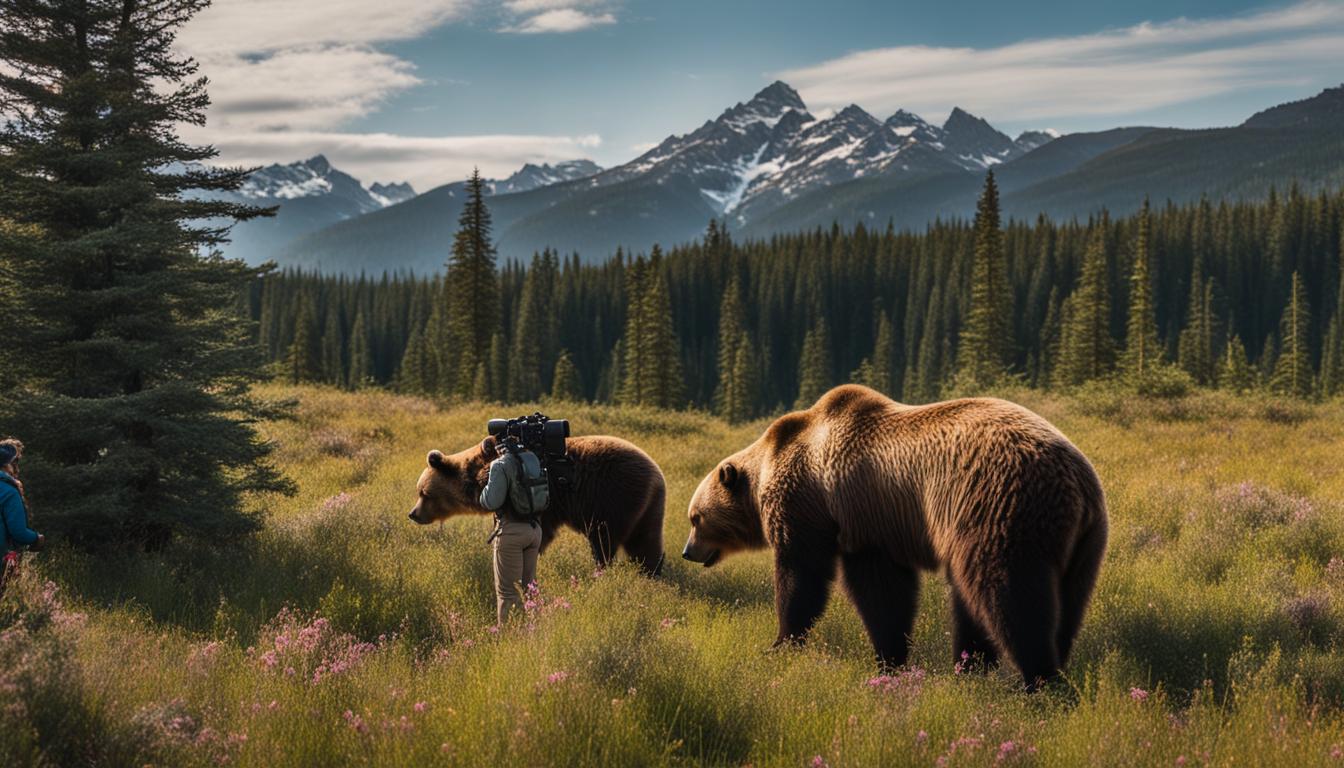When embarking on a backpacking adventure, it’s important to not only enjoy the scenic beauty of nature but also respect the wildlife that calls it home. Observing wildlife in their natural habitat is a thrilling experience that can create lasting memories. However, to ensure both your safety and the well-being of the animals, it’s essential to follow a few guidelines. In this section, I will provide you with tips and techniques on how to safely observe wildlife while backpacking.
Key Takeaways:
- Know and adhere to the specific guidelines of the park you are visiting.
- Maintain a safe distance from wildlife and predators.
- Avoid disturbing or provoking animals.
- Stay on designated trails and be cautious when driving.
- Properly store food and report any wildlife encounters to park rangers.
Wildlife Safety Tips for Backpackers
I have always been fascinated by the incredible diversity of wildlife that can be encountered while backpacking. From majestic bears to elusive wolves, observing these animals in their natural habitats is a thrilling experience. However, it is crucial to prioritize safety and practice responsible outdoor ethics when engaging in wildlife observation. Here are some essential wildlife safety tips for backpackers to ensure a safe and enjoyable experience.
“Avoid feeding wild animals, as it can be dangerous and lead to aggressive behavior towards humans.”
First and foremost, it is essential to avoid feeding wild animals. While it may be tempting to offer a snack to a curious squirrel or a friendly deer, feeding wildlife can have dangerous consequences. Animals that become dependent on human food can lose their natural foraging abilities, leading to aggressive behavior towards humans. Moreover, human food is often nutritionally inadequate for wild animals and can cause serious health issues. Therefore, it is crucial to refrain from feeding wild animals and respect their natural diet.
To ensure safety during wildlife observation, it is important to give animals their space and avoid invading their territory. While it can be exciting to get up close to a wild animal, it is crucial to remember that they are still wild and may react unpredictably. Maintaining a respectful distance helps minimize stress for the animal and reduces the risk of an unwanted interaction. Additionally, provoking or scaring animals can result in aggressive behavior, so it is important to observe from a safe distance and avoid any actions that may disturb them.
“Stay on the trail after dark to avoid unexpected encounters with animals.”
Another important tip is to stay on the trail after dark. While hiking at night can offer a unique experience, it can also increase the risk of unexpected encounters with animals. Many wildlife species are more active during nighttime, and venturing off-trail in the dark can lead to accidental encounters or disturbing their natural behaviors. By sticking to designated trails, backpackers can minimize their impact on wildlife and ensure their own safety.
Carrying bear spray and reporting encounters
When backpacking in bear country, it is crucial to carry bear spray as a precautionary measure. Bear spray is an effective deterrent that can help protect both humans and bears in the event of a close encounter. It is important to learn how to properly use bear spray and keep it easily accessible when hiking in areas known for bear activity.
Lastly, it is vital to report any wildlife encounters or close calls to park rangers. By sharing our observations, we can contribute to ongoing research and conservation efforts. This information helps park officials monitor wildlife populations, track behavioral patterns, and implement measures to ensure the safety and well-being of both wildlife and backpackers.
By following these wildlife safety tips, backpackers can enjoy the wonders of nature while ensuring the safety of themselves and the wildlife they encounter. Responsible wildlife observation not only protects animals and their habitats but also fosters a deeper appreciation for the natural world.
Tips for Successful Wildlife Observation

When it comes to wildlife observation, there are a few key tips that can enhance your experience and increase your chances of successful sightings. Whether you’re an avid photographer or simply enjoy immersing yourself in nature, these wilderness photography tips and wildlife conservation tips will help you make the most of your backpacking adventures.
Patience and Timing
One of the most important aspects of successful wildlife observation is patience. It’s essential to give animals the time and space they need, allowing them to behave naturally without disturbance. Choose optimal times for observation, such as early morning or late afternoon when animals are more active. This can significantly increase your chances of spotting wildlife in their natural habitats.
Approach and Camouflage
To get closer to wildlife without startling them, it’s crucial to consider your approach and camouflage. Pay attention to the wind direction and approach animals from an upwind direction to minimize the risk of detection by scent. Additionally, wearing neutral-colored clothing that blends in with the surroundings can help minimize your visual impact and enable you to observe wildlife more closely.
Responsible Behavior and Conservation
Finally, it’s essential to practice responsible behavior and contribute to wildlife conservation efforts. Avoid leaving food scraps behind, as this can habituate animals to human food and disrupt their natural behavior. Safeguard your food using odor-proof bags, canisters, or hanging techniques to prevent attracting wildlife. By maintaining a respectful distance and relying on binoculars or zoom lenses, you can observe wildlife up close while minimizing your impact on their habitat.
Remember, the key to successful wildlife observation is to observe without disturbing. By following these tips and respecting the natural environment, you can have incredible wildlife encounters while contributing to the preservation and conservation of these magnificent creatures.
Conclusion
Safely observing wildlife while backpacking requires responsible and respectful behavior towards both animals and their natural environment. It is crucial to follow the guidelines provided by the park you are visiting, including minimum viewing distances and food storage requirements. By giving animals their space and refraining from disturbing them, we can minimize our impact and ensure their well-being.
Remember, wildlife encounters should be seen as a privilege, and it is important to approach them with caution and respect. Our actions have the power to affect the lives of these creatures and the delicate balance of their ecosystems. Let us embrace the opportunity to observe nature’s wonders while contributing to wildlife conservation efforts during our backpacking adventures.
As we venture into the wilderness, let us practice patience and choose optimal times for wildlife observation. By wearing appropriate clothing, minimizing our visual impact, and safeguarding our food, we can enhance our chances of successful observation without disrupting the animals’ natural behavior. Let us remember that wildlife belongs in the wild, and it is our responsibility to preserve and protect their wildness for generations to come.
How Can I Safely Observe Wildlife While Avoiding Encountering Bears While Backpacking?
When planning to encounter a bear while backpacking, follow guidelines to safely observe wildlife. Make noise to avoid surprising bears, stay alert in areas with bear activity, carry bear spray, and store food properly. Keep a safe distance and never approach a bear for a photo op.
FAQ
What are some general safety guidelines when observing wildlife while backpacking?
Know the specific guidelines of the park you are visiting, including minimum wildlife viewing distances and food storage requirements. Give animals enough space by maintaining a minimum distance of 25 yards from most wildlife and 100 yards from predators like bears and wolves. Avoid disturbing wildlife by refraining from feeding, touching, teasing, or intentionally disturbing them. Stay on designated trails to minimize human presence in unpredictable areas. Be cautious when driving and watch for wildlife on the roads. Store your food properly and dispose of trash in wildlife-resistant containers. Report any wildlife encounters or sightings to a park ranger.
Is it safe to feed wild animals while backpacking?
No, it is not safe to feed wild animals. Feeding them can be dangerous and lead to aggressive behavior towards humans. It is important to respect the natural behavior of wildlife and refrain from feeding them.
Can I touch or pet wild animals while backpacking?
It is best to avoid attempting to touch or pet wild animals while backpacking. Although they may appear friendly or harmless, they are still wild and may react unpredictably. Giving animals their space and refraining from touching them is the safest approach.
What should I do if I encounter a potentially dangerous animal?
If you encounter a potentially dangerous animal, such as a bear or wolf, it is important to stay calm and slowly back away. Do not turn your back on the animal or run, as this may trigger a chase response. Maintain a respectful distance and report the encounter to park rangers as soon as possible.
Are there any specific tips for nighttime wildlife observation?
It is advisable to stay on the trail after dark to avoid unexpected encounters with animals. Make noise to alert animals of your presence while hiking. Use a flashlight or headlamp to navigate the trail safely. It is important to be aware of your surroundings and avoid surprising nocturnal wildlife.
How can I minimize my impact on wildlife while observing them?
Minimize your visual impact by wearing neutral-colored clothing and blending in with the surroundings. Avoid leaving food scraps behind, as it can habituate animals to human food. Safeguard your food using odor-proof bags, canisters, or hanging techniques. Maintain a respectful distance and rely on binoculars or zoom lenses for closer observation. Learn about the behavioral patterns of the wildlife you are likely to encounter to enhance your chances of successful observation.
Why is responsible behavior important during wildlife observation?
Safely observing wildlife while backpacking requires responsible and respectful behavior towards both animals and their natural environment. By following guidelines, giving animals their space, and minimizing our impact, we can enjoy the wonders of wildlife while preserving their wildness. Remember that wildlife encounters should be a privilege and that our actions can affect their well-being. Embrace the opportunity to observe nature’s wonders and contribute to wildlife conservation efforts during your backpacking adventures.

